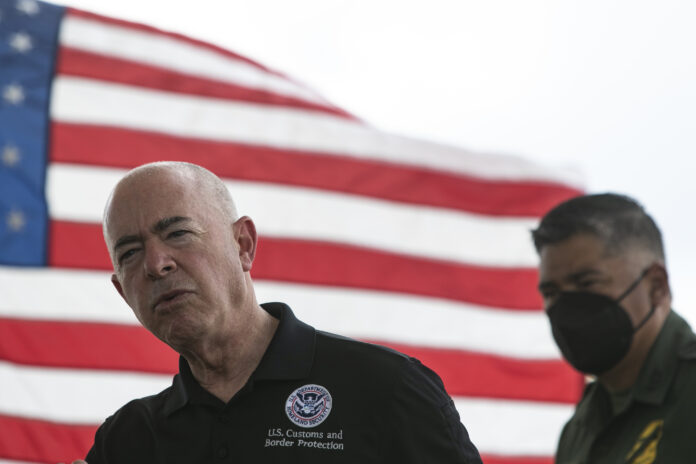BROWNSVILLE — Rio Grande Valley public officials who met with Department of Homeland Security Secretary Alejandro Mayorkas on Thursday are optimistic but skeptical of any immediate relief local communities will see as they continue to face challenges in sheltering a growing number of migrants released from federal custody.
Mayorkas met privately with local officials, federal agents and nongovernmental organizations throughout the day and held a news conference midday at the Brownsville Border Patrol station.
“The situation at the border is one of the toughest challenges we face. It’s complicated, changing and involves vulnerable people at a time of a global pandemic,” Mayorkas said under a canopy as an American flag hung overhead and Border Patrol vehicles were parked nearby.
Mayorkas shared the latest border apprehension data for the month of July.
U.S. Customs and Border Protection recorded 212,672 encounters along the border, an increase of 13% from June. Nearly half of them, 52%, were single adults.
U.S. Rep. Henry Cuellar, D-Laredo, shared more updated figures that included data through Aug. 11. So far this year, agents made 1.3 million apprehensions, and the Valley continues to be the busiest crossing point across the border with 443,000 apprehensions.
Across Texas, agents arrested an average of about 20,000 migrants per week.
“Twenty-thousand a week?” Hidalgo County Judge Richard Cortez asked rhetorically. “I mean, who can handle 20,000 a week?”
Emergency declarations and letters requesting assistance were signed and sent last week by Hidalgo County, the city of McAllen and Cameron County Judge Eddie Trevino.
A combined effort between McAllen and Hidalgo County Precinct 3 led to the creation of an emergency site the next day, though it was later moved to Anzalduas park.
“You’re not prepared to handle 20,000 a week,” Cortez said. “You don’t have any facilities to test them. You don’t have any facilities to keep them if they have COVID. So, what do you mean you’re going to continue to let 20,000 come in here when you’re not able to take care of them now.”
Data shared by Mayorkas indicated a federal public health code, known as Title 42, remains in effect and it’s been leveraged to expel nearly half, or 45%, of all migrants entering the country.
In spite of the continued enforcement of Title 42 expulsions, fewer and fewer migrants are being turned back to Mexico since June, a trend that carried into July.
Recalcitrant Mexican states that have pushed back and imposed rules on which type of migrant families they’re willing to accept have also contributed to the rise in families allowed to stay in the U.S.
In July, about 88% of all migrant families who crossed into the U.S. were not immediately sent back through Title 42.
Mayorkas visited Mexico just before arriving in the Valley this week to attempt to create other pathways for asylum seekers that do not include sojourning through Mexico.
Recently, DHS began flying Central Americans back, but only as far as south Mexico, not their home countries. Through bilateral efforts, Guatemala officials then bus the migrants to remote Guatemalan cities, even if the families are from Honduras or El Salvador.
Mayorkas said the intention behind the controversial strategy is to deter and slow down migrants who are returning back to the U.S. at a faster rate than before.
Of all the migrants who entered into the country in July, about 27% of them had already made the journey at least once within the last year. That rate, known as recidivism, increased by 13% compared to last year.
Families who are allowed to stay on the U.S. side of the border may end up in Hidalgo County, where local officials are requesting quick relief.
Officials proposed a moratorium on releasing migrants into communities.
“We need a quick fix. And a quick fix is we have to say, ‘no more for right now,’” Cortez said.
Treviño, the Cameron County judge, also supported the proposal.
“At a bare minimum, temporarily stop the surge and give our federal agencies, CBP, Border Patrol, DHS, the opportunity to galvanize and be able to handle the numbers that are currently already here,” Treviño said.
While Cameron County responds to the situation, their largest city, Brownsville, handles the day to day flow more directly. In a statement Thursday, Brownsville Mayor Trey Mendez said he spoke with Mayorkas.
“I had an opportunity to sit down with the secretary and explain Brownsville’s process and how it might be replicated in other border communities,” Mendez said in the statement. “Our city’s focus on efficiency and getting people out quickly has helped us avoid public safety and capacity issues. The Secretary was cordial and receptive to ideas for controlling the flow. Eventually, I hope to see a system where individuals are screened, processed, tested and vaccinated prior to coming to the border.”
U.S. Rep. Cuellar described the meeting as a “listening session,” and other officials said the secretary did not disclose plans to address their immediate concerns.
Treviño is hopeful the opportunity will yield fruit in given time.
“It’s an opportunity you need to take advantage of,” Treviño said. “He did communicate that the (Biden) administration had been in talks and discussions with Mexican government officials. So, hopefully that will also bear some fruit so that Mexico can also assist us with the number of the immigrants arriving at all of our border points.”
Cortez remained skeptical.
“I don’t know yet,” he said about the effectiveness of the secretary’s visit. “This was the first time in weeks that the Biden administration responded to our pleas for help. So, at least, it’s a good first step.”
View the full photo gallery below:
Photo Gallery: DHS Secretary Alejandro Mayorkas’ border visit




